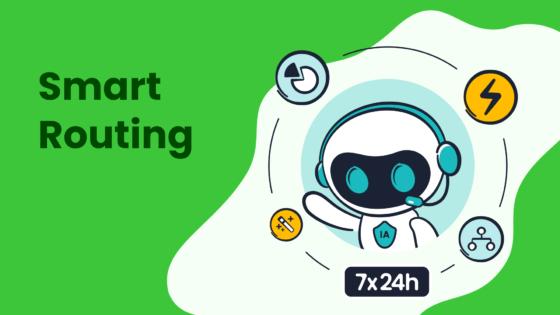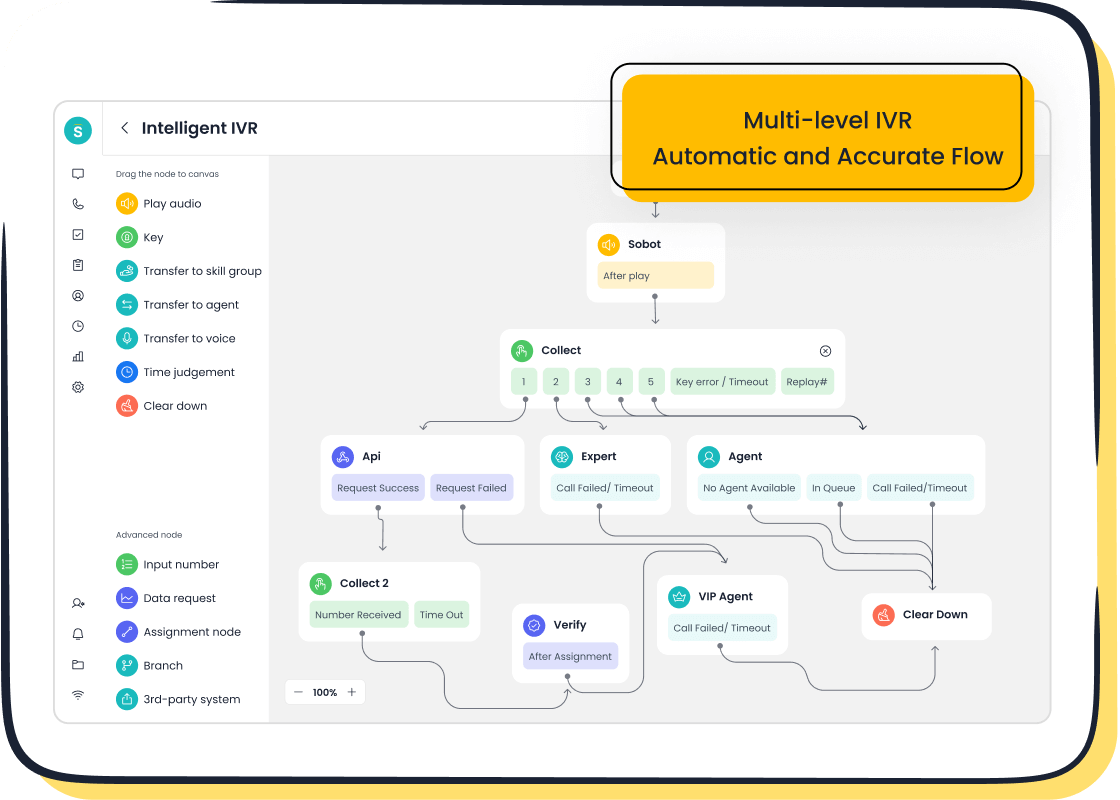How Automatic Phone Routing Enhances Customer Experience

Imagine calling a company and waiting endlessly to speak to the right person. Frustrating, isn’t it? Automatic phone routing (APR) eliminates this hassle by directing your call to the most suitable agent in seconds. This technology transforms customer service by reducing wait times and improving efficiency. For example, businesses using APR report higher first-call resolution rates, which directly boosts customer satisfaction. Companies like Sobot integrate APR with intelligent tools, ensuring seamless communication. Whether you need quick answers or personalized support, APR ensures you get the help you need without delays.
Understanding Automatic Phone Routing (APR)
What Is Automatic Phone Routing?
Definition and Purpose of APR
Automatic phone routing (APR) is a technology that directs incoming calls to the most suitable agent or department based on predefined rules and customer input. Its primary purpose is to streamline call routing processes, ensuring customers receive prompt and accurate assistance. Unlike traditional systems, APR leverages advanced tools like intelligent IVR (Interactive Voice Response) and AI to analyze caller data and make real-time decisions. This approach reduces wait times and enhances the overall customer experience.

APR systems offer a variety of features that cater to different business needs. For example, call qualifying identifies the reason for a call, while skills-based routing ensures complex issues are handled by agents with the right expertise. Companies like Sobot integrate APR with CRM systems, enabling seamless access to customer data and improving service efficiency.
How APR Differs from Traditional Call Routing
Traditional call routing relies on static rules, such as routing calls based on the time of day or the caller's location. While functional, this method often leads to inefficiencies, such as misdirected calls or long wait times. APR, on the other hand, uses dynamic and intelligent routing methods. Features like AI-assisted predictive routing and skills-based routing ensure calls are directed to the best-suited agent. For instance, APR can prioritize VIP customers or match callers with agents in the same time zone, creating a more personalized experience.
| Feature Type | Description |
|---|---|
| Call Qualifying | Determines the reason for the call using IVR or caller ID information. |
| Call Queuing | Places the caller in the appropriate queue based on their reason for calling. |
| Call Distributing | Transfers the call to the best-suited agent based on qualifying details and preset rules. |
| Skills-Based Routing | Directs calls to agents with the appropriate skills for complex issues. |
| AI-Assisted Predictive | Uses AI to analyze data and predict the best agent for the caller based on historical data. |
The Role of Skill-Based Routing in APR
Matching Customer Needs with Agent Expertise
Skill-based routing is a cornerstone of APR. It ensures that calls are directed to agents with the specific skills required to address the customer's issue. For example, a technical support call would be routed to an agent with expertise in troubleshooting, while a billing inquiry would go to someone familiar with payment systems. This targeted approach minimizes the risk of miscommunication and enhances the efficiency of customer interactions.
Sobot’s Voice/Call Center exemplifies this by integrating skills-based routing with intelligent IVR. The system identifies customer needs through input and routes calls to agents with the right expertise. This ensures that customers receive accurate and timely assistance, improving their overall experience.
Enhancing First-Call Resolution Rates
Skills-based routing significantly improves first-call resolution rates. By connecting customers to the right agent on the first attempt, it reduces the need for call transfers and follow-ups. This not only saves time but also boosts customer satisfaction. Businesses using skills-based routing report benefits such as reduced call handling time and higher resolution rates. For instance, Sobot’s AI-powered Voicebot enhances this process by analyzing customer data and predicting the best agent for each call.
- Improved customer satisfaction
- Reduced call handling time
- Increased first-call resolution rates
By leveraging skills-based routing, companies can create a seamless and frustration-free experience for their customers.
How Automatic Phone Routing Works
The Technology Behind APR
Intelligent IVR Systems and Their Role
Intelligent IVR systems form the backbone of automatic phone routing. These systems use advanced technology to interact with callers, collect input, and guide them to the most suitable agent. For example, when you call a company, the IVR system might ask you to select an option based on your issue. This input helps the system identify your needs and route your call efficiently. Unlike traditional IVR, intelligent systems can recognize natural language, making interactions smoother and more intuitive.
Sobot’s Voice/Call Center takes this a step further by offering a drag-and-drop IVR builder. This feature allows businesses to customize call flows in real time, ensuring flexibility and adaptability. With intelligent IVR, companies can reduce wait times and improve first-call resolution rates, creating a better experience for you as a customer.
Integration with CRM and Customer Data
Integrating APR with CRM systems enhances customer service efficiency. When your call is routed, the system pulls relevant data from the CRM, such as your purchase history or previous interactions. This empowers agents to address your concerns more effectively.
- Streamlines communication by linking customer databases with call routing.
- Automates routine tasks, allowing agents to focus on complex issues.
- Provides quick access to critical customer information, improving call handling.

Sobot’s platform excels in this area by seamlessly integrating with existing CRM systems. This ensures that agents have all the information they need at their fingertips, enabling faster and more personalized service.
The Process of Skill-Based Routing
Identifying Customer Needs Through Input
Identifying customer needs is the first step in skill-based routing. The system evaluates your input, such as the options you select in the IVR menu or keywords you mention during the call. This helps categorize your issue and match it with the right expertise.
Here’s how companies achieve this:
- Evaluate current setups to understand existing skills and customer needs.
- Categorize skills based on high-priority needs.
- Match agents with the necessary skills to handle specific inquiries.
- Analyze ongoing data to refine and improve the routing process.
By following these steps, businesses ensure that your call reaches the most suitable agent, saving time and reducing frustration.
Routing Calls to the Most Qualified Agents
Once your needs are identified, the system uses intelligent skill-based routing to connect you with a specialized agent. This process ensures that the agent handling your call has the expertise required to resolve your issue. Metrics like resolution time and first-call resolution rates measure the success of this approach.
| Metric | What to Watch | Why It’s Important |
|---|---|---|
| Resolution Time | How long it takes to resolve issues | Measures routing efficiency |
| First-Call Resolution | Percentage of problems solved in one interaction | Reflects how well skills match customer needs |
| Customer Satisfaction | Feedback from post-call surveys | Indicates overall routing success |
| Agent Utilization | Workload distribution across agents | Highlights balance and efficiency |
Sobot’s intelligent skill-based routing ensures that calls are directed to the most qualified agents. This reduces call transfers and enhances your overall experience, making every interaction seamless and efficient.
Benefits of Automatic Phone Routing for Customer Experience
Faster and More Efficient Service
Reducing wait times with smart call routing

Smart call routing ensures your calls reach the right agent without unnecessary delays. By analyzing your input, such as menu selections or spoken keywords, the system identifies your needs instantly. This reduces the time you spend waiting in queues or being transferred between departments. For example, Sobot’s Voice/Call Center uses intelligent IVR and skills-based routing to connect you with the most qualified agent in seconds. Businesses using this technology report significant reductions in average wait times, enhancing your overall customer experience.
Ensuring first-contact resolution
First-contact resolution is a key metric in customer service. Automatic phone routing improves this by directing your call to an agent equipped with the right skill set. When your issue is resolved on the first attempt, it saves you time and eliminates frustration. Sobot’s AI-powered Voicebot enhances this process by analyzing customer data and predicting the best match for your needs. This approach ensures that your concerns are addressed promptly, boosting customer satisfaction.
Personalized Customer Interactions
Leveraging customer data for tailored experiences
Automatic phone routing integrates seamlessly with CRM systems, allowing agents to access your data during the call. This includes your purchase history, previous interactions, and preferences. With this information, agents can provide personalized interaction tailored to your needs. For instance, if you frequently call about technical issues, the system routes you to a technical expert. This creates a more meaningful and efficient experience for you.
Building stronger customer relationships
Personalized interactions foster trust and loyalty. When agents address your concerns with precision and empathy, it strengthens your relationship with the company. Sobot’s platform excels in this area by centralizing customer data and enabling agents to deliver consistent, high-quality service. This not only improves your satisfaction but also encourages long-term engagement with the brand.
Improved Customer Satisfaction
Minimizing call transfers and escalations
Frequent call transfers often result from incorrect routing, unempowered agents, or communication silos. These issues frustrate you and waste valuable time. Automatic phone routing addresses these challenges by using skills-based routing to connect you with the right agent immediately. Empowering agents with the right tools and knowledge further reduces the need for escalations, enhancing customer satisfaction.
Creating a seamless and frustration-free experience
A seamless experience is essential for enhancing customer satisfaction. Automatic phone routing eliminates common pain points like long wait times and repeated explanations. By ensuring your call reaches the right agent with the necessary skill, the system creates a smooth and efficient process. Sobot’s Voice/Call Center, with its intelligent features, exemplifies how technology can transform customer service into a frustration-free experience.
Best Practices for Implementing Automatic Phone Routing
Leveraging Advanced Technology
Using AI and machine learning for smarter routing
AI and machine learning have revolutionized call routing by making it more intelligent and efficient. These technologies analyze customer data in real time to predict the best agent for each call. For example, AI can assess customer sentiment and call history to match them with agents who have the right skill. Predictive behavioral routing takes this further by connecting customers with agents based on past interactions, improving satisfaction. AI also continuously learns from previous calls, reducing wait times and enhancing operational efficiency.
Modern AI systems can even recognize customer emotions, enabling more personalized interactions. Sobot’s Voice/Call Center leverages AI to optimize call handling and ensure seamless communication. By investing in AI-driven tools, you can refine algorithms regularly and maintain data privacy, ensuring smarter and more secure call routing.

Integrating APR with tools like Sobot's Voice/Call Center
Integrating APR with advanced tools like Sobot’s Voice/Call Center enhances your call center’s efficiency. Sobot’s platform offers features like intelligent IVR and skill-based routing, which ensure calls are directed to the most qualified agents. Its seamless integration with CRM systems allows agents to access customer data instantly, improving call handling. Additionally, Sobot’s AI-powered Voicebot analyzes customer needs and automates routine tasks, freeing agents to focus on complex issues. This integration not only reduces costs but also creates a more personalized experience for your customers.
Understanding Customer Needs
Conducting customer journey mapping
Customer journey mapping helps you understand customer needs and improve call routing. Start by identifying customer goals and detailing their experiences across touchpoints. Look for opportunities to enhance these interactions and implement changes to address pain points. For example, if customers frequently face long wait times, you can optimize your IVR system to reduce delays. Measuring the impact of these changes ensures continuous improvement in your call center operations.
Identifying common pain points in call routing
Traditional call routing often frustrates customers due to issues like inconsistent experiences and long complaint resolution times. For instance, customers may encounter varying service quality across different platforms or limited accessibility on social media. Addressing these pain points requires a robust APR system. Sobot’s Voice/Call Center eliminates these challenges by offering consistent, high-quality service across channels. This ensures your customers enjoy a seamless and satisfying experience.
| Pain Point | Description |
|---|---|
| Inconsistency in experience | Customers find varying experiences across different channels and agents frustrating. |
| Conflicting experiences on different platforms | Customers report discrepancies in service quality across various platforms. |
| Unacceptable complaint resolution times | Long wait times for resolving complaints lead to dissatisfaction. |
| Minimal accessibility on social media | Limited support options on social media channels hinder customer engagement. |
| Unsatisfying experiences with support centers | Customers often feel let down by the quality of service received from support centers. |
Continuous Monitoring and Optimization
Analyzing call data for improvements
Analyzing call data is essential for optimizing your APR system. Use tools like conversation intelligence to identify areas where agents can improve. Call recordings and sentiment scores reveal recurring customer issues, helping you refine your call routing strategies. AI-driven tools automate quality assurance processes, while speech analytics detect key phrases that indicate critical moments in calls. These insights enable data-driven decisions, streamlining workflows and reducing call handling times.
Training agents to handle routed calls effectively
Even the best APR system requires skilled agents to deliver exceptional service. Regular training ensures agents can handle routed calls efficiently. Focus on improving their communication skills and equipping them with the knowledge to resolve issues quickly. Sobot’s Voice/Call Center supports this by providing real-time call monitoring and analytics, which help identify training needs. Well-trained agents not only enhance first-call resolution rates but also improve overall customer satisfaction.
Real-World Success Stories with Automatic Phone Routing
Case Study: Weee! and Sobot's Voice/Call Center
How flexible IVR improved customer satisfaction

Weee!, America’s largest online Asian supermarket, faced challenges with its rigid IVR system and language barriers. These issues slowed down customer support and frustrated callers. By adopting Sobot’s Voice/Call Center, Weee! implemented a flexible IVR system that adapted to customer needs in real time. This system allowed customers to navigate menus easily and connect with agents who had the right skill to address their concerns. Multilingual support further enhanced accessibility, ensuring customers felt understood and valued.
The results were remarkable. Weee! achieved a 96% customer satisfaction score, demonstrating how a tailored IVR system can transform the call center experience. Customers no longer endured long wait times or misdirected calls, which significantly improved their perception of the brand.
Achieving a 50% reduction in resolution time
Weee! also leveraged skill-based routing to match customers with agents who had the expertise to resolve issues quickly. This approach eliminated unnecessary call transfers and reduced resolution times by 50%. For example, technical inquiries were routed to agents trained in troubleshooting, while billing questions went to specialists in payment systems.
This efficiency not only saved time but also boosted agent productivity by 20%. With Sobot’s intelligent routing, Weee! streamlined its operations and ensured high-value customers received prompt, effective support. These improvements highlight how skill-based routing can enhance both operational efficiency and customer satisfaction.
Case Study: Financial Services Provider
Enhancing customer retention with skill-based routing
A leading financial services provider used skill-based routing to improve customer retention. By connecting customers to agents with the right skill for their specific needs, the company reduced resolution times and improved service quality. This personalized approach made customers feel valued, increasing their loyalty and reducing churn.
Consider these statistics: 73% of customers dislike long hold times, and 70% find being transferred to multiple agents frustrating. Skill-based routing addressed these pain points by ensuring customers reached the right agent immediately. This efficiency not only enhanced customer satisfaction but also strengthened long-term relationships with high-value customers.
Streamlining support for high-value clients
The financial services provider also implemented strategies to optimize support for high-value customers. Advisors saved up to five hours per week on administrative tasks, allowing them to focus more on client interactions. Automated documentation ensured compliance with regulations, while seamless integration with existing systems improved operational efficiency.
These changes enabled advisors to deliver personalized service, which significantly enhanced the client experience. The solution also scaled effortlessly, supporting business growth without requiring additional administrative staff. By prioritizing high-value customers, the company achieved higher satisfaction rates and positioned itself as a trusted partner in financial services.
Automatic phone routing has become a game-changer for modern call centers. By using tools like skill-based routing, you can ensure faster resolutions and more personalized interactions. This approach not only improves efficiency but also boosts customer satisfaction by reducing wait times and resolving issues on the first call. Sobot’s Voice/Call Center offers advanced features like intelligent IVR and seamless CRM integration, making it easier for businesses to deliver exceptional service. Investing in this technology helps you stay competitive in today’s customer-focused world.
FAQ
What is automatic phone routing, and how does it work?
Automatic phone routing directs your call to the most suitable agent based on your input or predefined rules. It uses intelligent IVR systems and customer data to analyze your needs in real time. For example, Sobot’s Voice/Call Center ensures seamless routing by integrating advanced AI and CRM systems.
How does skill-based routing improve customer service?
Skill-based routing connects you with agents who have the expertise to resolve your issue. This reduces call transfers and improves first-call resolution rates. Businesses using Sobot’s Voice/Call Center report faster resolutions and higher customer satisfaction, thanks to its intelligent routing features.
Can automatic phone routing handle high call volumes?
Yes, automatic phone routing efficiently manages high call volumes by prioritizing and routing calls based on urgency and agent availability. Sobot’s platform, with its 99.99% uptime and global network, ensures stable and reliable service even during peak times.
Is automatic phone routing suitable for small businesses?
Absolutely! Automatic phone routing benefits businesses of all sizes. Small businesses can use Sobot’s Voice/Call Center to automate call handling, reduce costs, and improve customer satisfaction. Its economic SaaS model makes it accessible and scalable for growing companies.
How does Sobot’s Voice/Call Center ensure data security?
Sobot’s Voice/Call Center uses encrypted data transfer and secure dialing to protect your information. With a 99.99% system uptime and compliance with global security standards, it ensures your data remains safe while delivering efficient and reliable service.
See Also
Understanding The Efficiency Of Call Center Automation
Enhancing Efficiency With AI-Powered Customer Service Tools
Essential Features To Look For In CRM Call Centers
